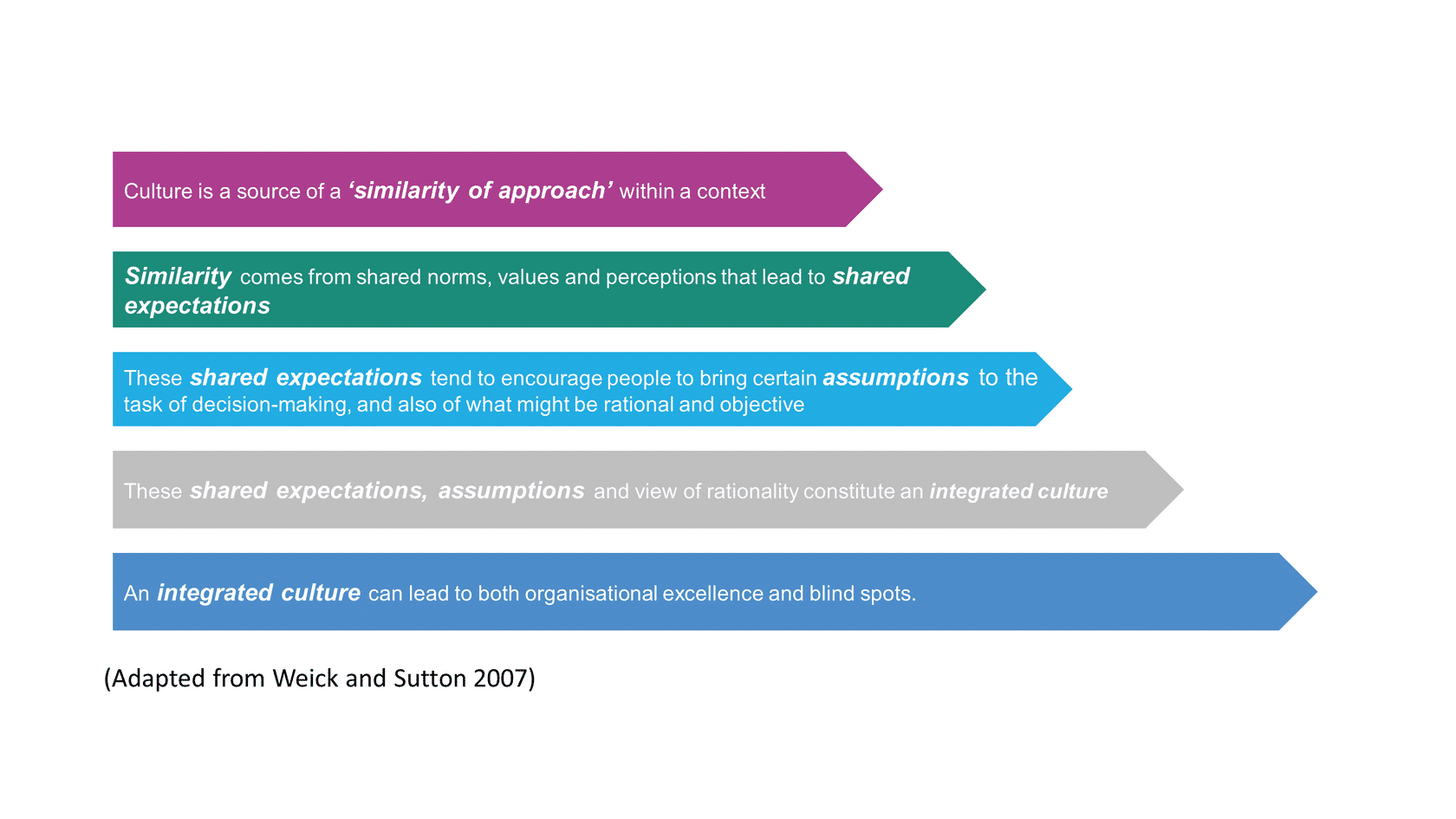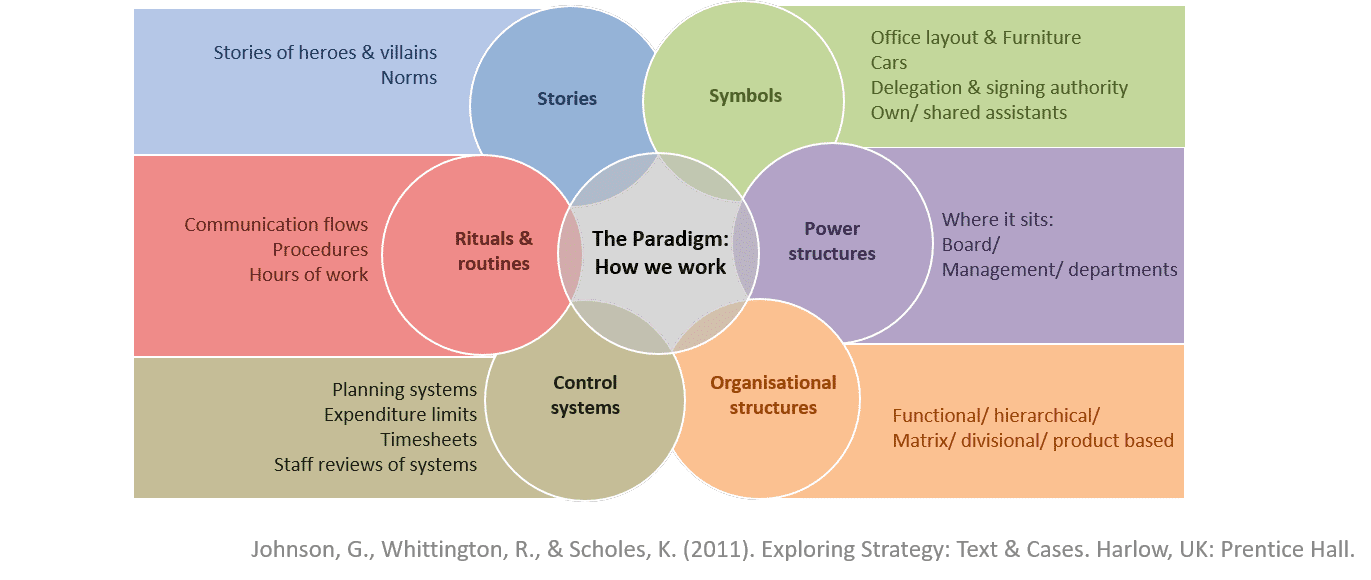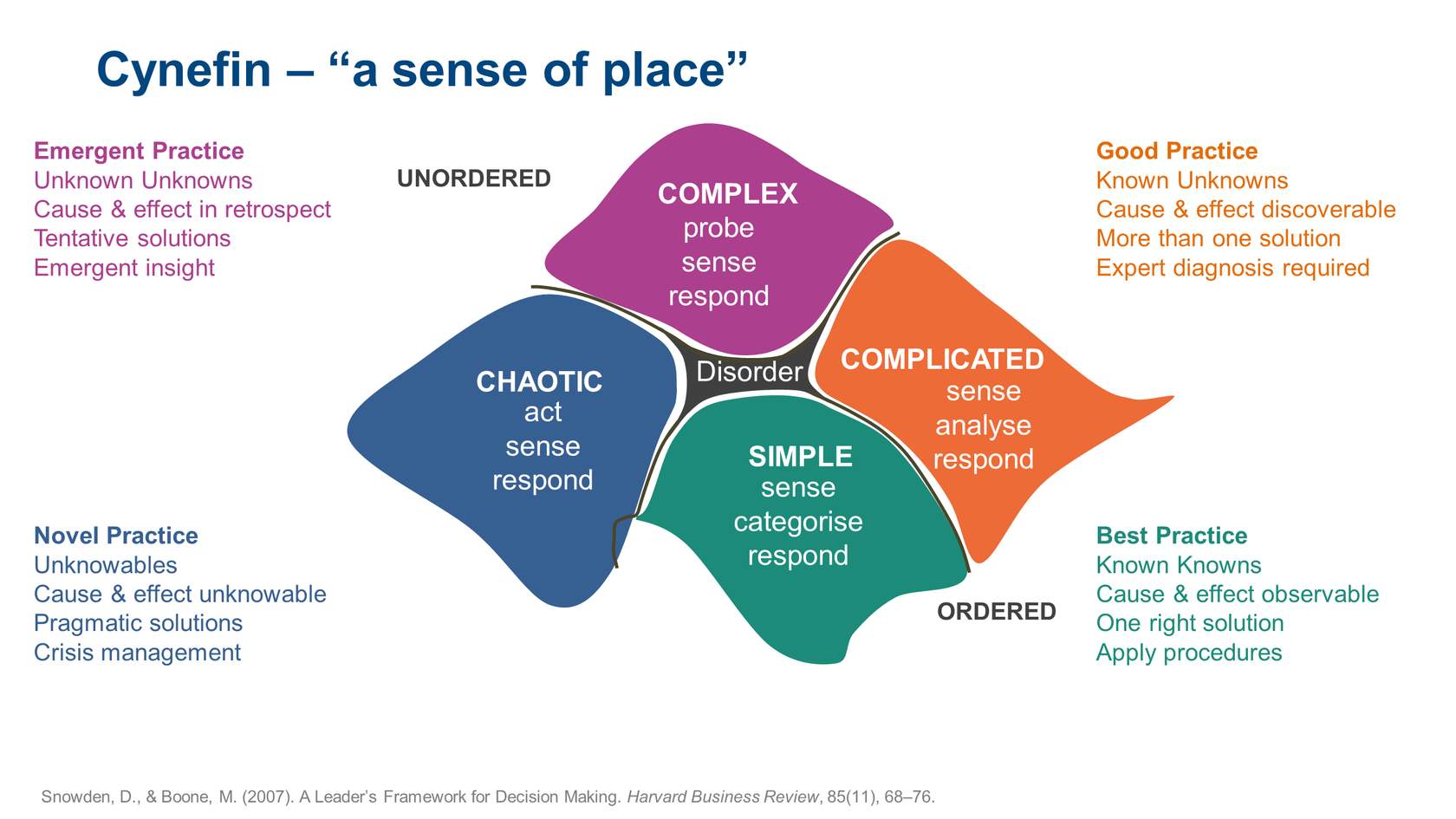78 Organisational Culture
Context and culture
Culture is what holds groups and organisations together.1 Culture emerges from the set of expectations that we have of people in a specific context, and from the expectations that matter to those involved. An important point is that people shape culture, and culture shapes people.
Weick & Sutton (2007) note the following:

Culture can lead to success and failure. We all know what a great culture feels like and how it can help us thrive. There can be a dark side to culture as well.
Based on the concept of culture as ‘what we expect around here’, Weick and Sutcliffe warn against cultural entrapment as a cause of failure.2 This is a process by which people get trapped into patterns of behaviour that may be destructive or lead to poor and unethical outcomes. In this state the members may blame the culture for those poor outcomes because ‘that is the way we do things around here’.
Weick and Sutcliffe also explore the role of culture as a control mechanism. They suggest that a strong culture, bound by consistent values and enforced by social pressure works as an organisational control mechanism. This can be very powerful and productive. To create such an environment, consensus, intensity and values are a powerful guide.
Here are two issues for you to ponder:
Explore examples of Cultural entrapment in your organisation. What are the consequences? How would they be changed?
The Cultural Web
Here is another way to explore your culture using the Cultural Web. It works well for HROs and similar organisations where the culture is crucial to the safety and well-being of members as much as it is to the delivery of the overall mission and purpose. It has been used in various police forces to understand the culture and also as a way to shift culture to make it more open to new recruits and also to create diversity.
The Cultural Web helps us to understand the ‘why’ of these things about your place of work, whether you are in barracks, in the field, or off location:
- The way it ‘feels’ and ‘looks’ around here.
- The way we do things around here.
- The basic assumptions about how things work around here that most of the soldiers share.
- What drives our perceptions, attitudes, feelings and behaviours.
- How we behave when nobody is looking.
Adapted from: Johnson, G., Whittington, R., Scholes, K., Angwin, D., & Regner, P. (2014). Exploring Strategy: Text and Cases (10 ed.). Pearson Education Limited.

E4mVZrLvN41hhjiB-TheCulturalWebTemplate
The Cultural Web framework provides a tool that helps us understand the way we do things around here. When we use this tool to also think about the way we would ‘like’ to do things we can start to see the gaps and more clearly identify where to take action.
In relation to change, creativity and innovation this is a very useful activity. Examining the cultural web of your team, barracks and the Army more generally may generate ideas for new initiatives. Understanding the strengths and weaknesses of the web may help you foresee and circumvent obstacles to implementation. Mapping your cultural web may even provide you with a way of measuring progress.
Here is a template for you to use. Make notes about each of the elements of your culture and write up your observations in the section titled ‘Your Insights’.
Consider your change opportunity. What insights do you have from thinking about culture? What elements of the culture can you leverage when you are figuring out how to develop and implement your change opportunity? What elements of the culture might be barriers?
Cynefin and Complexity: Decisions and Problems
The Cynefin framework helps to understand what it is that we are facing and whether it is a challenge or opportunity that we can easily solve or whether it is likely to present unknowlege and very difficult situations.
David Snowden,3 the complexity thinker, notes that when we are confronted with contexts and situations when we need to decide and act, “ … we will interpret the situation according to our personal preference for action”4.
To address this, The Cynefin Framework “gives us a very easy way of deciding how to work but it [also] gives us a divergent [way of thinking] – we sometimes call this requisite applicability. It basically says dependent on which space you’re in you should think differently, should analyze differently, rather the one-size-fits-all which has been a tradition of management theory” 5.

Watch the Cynefin Decision framework video presented by David Snowden:
Consider where in the decision framework the set of decisions you need to make, should fit. Consider the likely mindset of the organisations that would potentially be making these long term strategic decisions. Ponder this for a moment.
As you watch the video, listen carefully for the nuances about each space, and be careful about the ‘cliff space’ between Simple and Chaotic.
Consider your observations and reactions in the context of your current, and perhaps, past situations of decisions making, actions and outcomes.
Ponder these questions
- How does the framework add to your understanding of how people, teams and organisations ‘get things done’?
- How might you use this complexity decision framework in your own work?
- Think about your own view of the world. What is your default approach to issues and decision situations?
- Think about how you might share with your immediate team your insights and preferences.
- How might you deal with these in your work context? What impact will your preferences, and those of others, have on the outcomes?
You have explored the culture around you. You have thought about the kinds of challenges and opportunities that arise and you have also thought about the way that you fit in the culture and the way that you instinctively approach problems and challenges. This is a very important part of Act Two!
References
- Weick, K.E. & Sutton, K.M. (2007). Organizational Culture: Institutionalizing Mindfulness. In Managing the unexpected: Resilient Performance in an age of uncertainty (pp.109 – 138). Hoboken: Jossey-Bass.
- Weick, K. E., & Sutcliffe, K. M. (2003). Hospitals as cultures of entrapment: a re-analysis of the Bristol Royal Infirmary. California management review, 45(2), 73-84.
- Snowden, D. , & Boone, M. (2007). A Leader’s Framework for Decision Making. Harvard Business Review, 85(11), 68-76.
- Snowden, D. [CognitiveEdge]. (2010, July, 11). The Cynefin Framework [Video file]. Retrieved from https://youtu.be/N7oz366X0-8
- Ibid.




